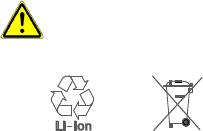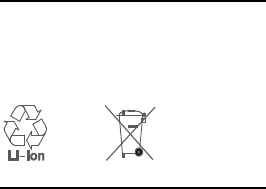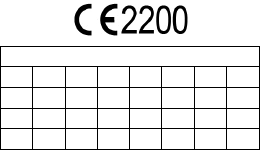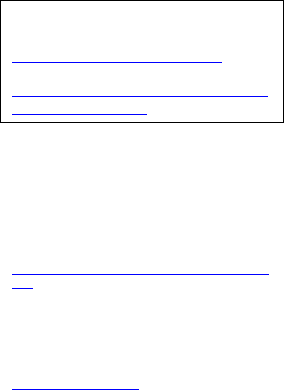HTC 2PST300 Smartphone User Manual ASN VzW WWE SafetyGuide 20160518
HTC Corporation Smartphone ASN VzW WWE SafetyGuide 20160518
HTC >
Contents
- 1. User manual
- 2. User manual statement
User manual statement

Product
safety &
warranty
information.

2 Safety and regulatory guide
Please read before proceeding
THE BATTERY IS NOT FULLY CHARGED WHEN
YOU TAKE THE DEVICE OUT OF THE BOX.
YOUR WARRANTY IS INVALIDATED IF YOU
DISASSEMBLE OR ATTEMPT TO DISASSEMBLE
THE DEVICE.
Privacy restrictions
Some countries require full disclosure of
recorded telephone conversations.
Important health information and
safety precautions
READ THE FOLLOWING WARNINGS AND
INFORMATION BEFORE USE OF THE PRODUCT
AND FOLLOW ALL PRODUCT SAFETY AND
OPERATING INSTRUCTIONS. FAILURE TO DO
SO MAY CAUSE BODILY INJURY, ELECTRIC
SHOCK, FIRE, AND OTHER DAMAGE.
Electrical safety
Do not attempt to disassemble the phone or its
accessory. Only qualified personnel must
service or repair the phone or its accessories.
Do not connect with incompatible products or
accessories.
Do not touch the SIM card’s metal connectors
as this may cause an electrostatic discharge.
CAUTION
: Connecting to improperly grounded
equipment can result in an electric shock to your
device.
This product is equipped with a USB Cable for
connecting with desktop or notebook computer.
Be sure your computer is properly grounded
(earthed) before connecting this product to the
computer. The power supply cord of a desktop
or notebook computer has an
equipment-grounding conductor and a
grounding plug. The plug must be plugged into
an appropriate outlet which is properly installed

Safety and regulatory guide 3
and grounded in accordance with all local codes
and ordinances.
Safety precautions for battery and power
supply
Use the correct external power source
A product should be operated only from the
type of power source indicated on the
electrical ratings label
AC adapter:
HTC, TC U250
Your device should only be operated with the
HTC qualified battery pack, model number
B2PST100
Operating temperature range: 32 °F
to 104 °F (0 °C to 40 °C)
Handle battery packs carefully
This product contains a Lithium-ion polymer or
Lithium-ion battery. There is a risk of fire and burns
if the battery pack is handled improperly.
WARNING
: To reduce risk
of fire or burns,
do not disassemble, crush, puncture, short
external contacts or circuits, expose to
temperature above 40 °C (104 °F), or
dispose of in fire or water.
Additional precautions
Keep the device dry and away from water or
any liquid as it may cause a short circuit.
The phone should only be connected to
products that bear the USB-IF logo or have
completed the USB-IF compliance program.
Only use the battery with a charging system
that has been qualified with the system per
this standard, IEEE-Std-1725. Use of an
unqualified battery or charger may present a
risk of fire, explosion, leakage or other
hazard.
4 Safety and regulatory guide
Avoid dropping the phone. If the phone or
battery is dropped, especially on a hard
surface, and the user suspects damage, take
it to a service centre for inspection.
If the battery leaks:
Do not allow the leaking fluid to come in
contact with skin or clothing. If already in
contact, flush the affected area immediately
with clean water and seek medical advice.
Do not allow the leaking fluid to come in
contact with eyes. If already in contact, DO
NOT rub; rinse with clean water immediately
and seek medical advice.
Take extra precautions to keep a leaking
battery away from fire as there is a danger
of ignition or explosion.
Safety precautions related to weather,
temperature and moisture
Keep this product away from water, excessive
moisture and extreme temperatures. Avoid hot
areas. The product should be kept away from
heat sources such as radiators, heat registers,
stoves, or other products that produce heat. Do
not leave the product inside a vehicle or in places
where the temperature may exceed 40 °C (104
°F), such as on a car dashboard, window sill, or
behind glass that is exposed to direct sunlight or
strong ultraviolet light for extended periods of
time. This may damage the product, overheat the
battery, or pose a risk to the vehicle.
Avoid wet areas. Never use the product in rain, or
near washbasins or other wet or high humidity
locations, such as locations where the device
may be exposed to sweat or other liquids. If your
product gets wet, do not try to dry the product
with the use of an oven, dryer or microwave, as
this may damage your product.
Avoid using your device after a dramatic change
in temperature and/or humidity ranges, as

Safety and regulatory guide 5
condensation may form on or within the device.
To avoid damaging the device, allow sufficient
time for the moisture to evaporate before use.
Do not use your phone if it has been damaged.
Prevention of hearing loss
CAUTION
: Permanent hearing loss
may occur if earphones or
headphones are used at high volume
for prolonged periods of time.
Turn
down the device volume before using headphones
or other audio devices.
Using your phone while flying
Use of cell phones may be restricted on aircraft.
For your safety and the safety of other
passengers, always follow crew instructions
regarding the use of your phone.
Environmental hazards
When in any area with a potentially explosive
atmosphere or where flammable materials exist,
the product should be turned off and the user
should obey all signs and instructions.
Road safety
When behind the wheel, driving safely should
always be your first priority. According to the
National Highway Traffic Safety Administration
(NHTSA), scientific research indicates that using
a wireless phone while driving degrades a driver’s
performance, whether used in a hands-free or
hand-held mode. NHTSA advises that the “safest
course of action is to refrain from using a cell
phone while driving.” NHTSA’s policy on “Cell
Phone Use While Driving,” as well as Frequently
Asked Questions on the subject, are available at
www.nhtsa.gov. For your safety and the safety of
those around you, please consider turning your
phone off while you are driving.
6 Safety and regulatory guide
If you choose to use your phone while driving, be
aware that some state and local governments
have adopted laws governing the use of wireless
devices while driving. It is your responsibility to
know and comply with the laws in your area
General precautions
You alone are responsible for how you use your
phone and any consequences of its use. You
should switch off your phone wherever the use of
a phone is prohibited.
Avoid dropping, throwing, bending, or
applying excessive pressure to the device
Do not apply excessive pressure on the screen
and the device to prevent damaging them. It is
also recommended that you store the device in
a protective case and only use your finger
when interacting with the touch screen.
Cracked display screens due to improper
handling are not covered by the warranty.
Protect your phone
Always treat your phone and its accessories
with care and keep them in a clean and
dust-free place, and away from any
contaminants.
Do not expose your phone or its accessories
to open flames or lit tobacco products.
Do not paint your phone or its accessories.
Store your phone or its accessories at
temperatures between 0 °C to 40 °C (32 °F
to 104 °F).
Do not carry your phone in your back pocket
as it could break when you sit down.
Maintain a minimum separation distance of
1.5 cm between the phone and your body.
Damage requiring service
Unplug the product from the electrical outlet
and contact HTC’s customer support via our
website (www.htc.com) to locate an
authorized service technician or provider that
Safety and regulatory guide 7
can service your device if:
The product has been damaged by being
exposed to rain or liquid, dropped, or subject
to impact.
There are noticeable signs of overheating.
The product does not operate normally
when you follow the operating instructions.
Avoid pushing objects into product
Never push objects of any kind into cabinet
slots or other openings in the product. These
openings must not be blocked or covered.
Cleaning
Unplug the product from the wall outlet before
cleaning. Do not use liquid cleaners, harsh
chemicals, cleaning solvents or aerosols on the
device or accessories. Use a damp cloth for
cleaning, but NEVER use water to clean the
LCD screen.
Small children
Use of your device by small children should be
supervised by an adult. They could hurt
themselves or others, or could accidentally
damage the phone. Your phone contains small
parts with sharp edges that may cause an
injury or which could become detached and
create a choking hazard. Consult the doctor
immediately if the accessories or battery are
swallowed.
Repetitive motion injuries
To minimise the risk of RSI, when Texting or
playing games with your phone:
Do not grip the phone too tightly.
Press the buttons lightly.
Emergency calls
This phone, like any wireless phone, operates
using radio signals, which cannot guarantee
connection in all conditions. Therefore, you
must never rely solely on any wireless phone
for emergency communications.

8 Safety and regulatory guide
Disposal of your device
Please do not discard your device in a landfill.
Electronic devices contain substances that may
be hazardous to the environment if not properly
disposed of. Please safely dispose of your
device through HTC’s free mail-back recycling
program at www.freeurecycle.com or by locating
an e-waste drop-off point in your community.
Regulatory agency identifications
For regulatory identification purposes, your
product is assigned a model number of
2PST300
(HTCD160L).
Your phone’s FCC ID is
NM82PST300
. This FCC
ID can also be found printed on the back of the
device.
To view your FCC ID in your device you may also
go to the Settings menu
About
Legal
Information
Regulatory.
European Union notice
Products with CE marking comply with the
R&TTE Directive 1999/5/EC, the EMC Directive
2004/108/EC (until 19th April, 2016) and EMC
Directive 2014/30/EU (from 20th April, 2016) and
the Low Voltage Directive 2006/95/EC (until
19th April, 2016) and Low Voltage Directive
2014/35/EU (from 20th April, 2016) issued by the
Commission of the European Community.
Compliance with these directives implies
conformity to the following European Norms (in
parentheses are the equivalent international
standards).
EN 50360
EN 50566
EN 62479

Safety and regulatory guide 9
EN 62209-1
EN 62209-2
EN 60950-1
EN 301 489-1
EN 301 489-3
EN 301 489-7
EN 301 489-17
EN 301 489-24
EN 300 328
EN 300 440-1
EN 300 440-2
EN 301 908-1
EN 301 908-2
EN 301 511
This equipment may be operated in:
AT
BE
BG
CH
CY
CZ
DE
DK
EE
ES
FI
FR
GB
GR
HU
IE
IT
IS
LI
LT
LU
LV
MT
NL
NO
PL
PT
RO
SE
SI
SK
TR
Federal Communication Commission
interference statement
This equipment has been tested and found to
comply with the limits for a Class B digital device,
pursuant to Part 15 of the FCC Rules. These limits
are designed to provide reasonable protection
against harmful interference in a residential
installation. This equipment generates uses and
can radiate radio frequency energy and, if not
installed and used in accordance with the
instructions, may cause harmful interference to
radio communications. However, there is no
guarantee that interference will not occur in a
particular installation. If this equipment does
cause harmful interference to radio or television
10 Safety and regulatory guide
reception, which can be determined by turning
the equipment off and on, the user is encouraged
to try to correct the interference by one of the
following measures:
Reorient or relocate the receiving antenna.
Increase the separation between the
equipment and receiver.
Connect the equipment into an outlet on a
circuit different from that to which the receiver
is connected.
Consult the dealer or an experienced radio or
television technician for help.
FCC Caution
: Any changes or modifications not
expressly approved by the party responsible for
compliance could void the user’s authority to
operate this equipment.
This device complies with Part 15 of the FCC
Rules. Operation is subject to the following two
conditions: (1) This device may not cause harmful
interference, and (2) this device must accept any
interference received, including interference that
may cause undesired operation.
FCC Hearing-Aid Compatibility (HAC)
regulations for wireless devices
The FCC has adopted rules to ensure reasonable
access to telecommunications services for
persons with hearing disabilities. As part of this
effort, the industry uses a rating system for
wireless phones to help hearing device users find
phones that may be compatible with their
hearing devices (hearing aids and cochlear
implants). This hearing-aid compatibility (HAC)
rating system is described in the American
National Standards Institute (ANSI) C63.19
standard and includes the following ratings:
M-Ratings:
For phones that use acoustic
coupling with hearing devices that are not
operating in telecoil mode.
Phones rated M3 or
Safety and regulatory guide 11
M4 meet FCC HAC requirements and are likely to
generate less radio frequency interference with
hearing devices than phones with lower ratings.
M4 is the better/higher of the two ratings. Your
2PST300
is rated
M4
.
T-Ratings:
For phones that use inductive
coupling with hearing devices operating in
telecoil mode.
Phones rated T3 or T4 meet FCC
HAC requirements and are likely to be more
usable with a hearing aid’s telecoil than phones
that are not rated. T4 is the better/higher of the
two ratings. Your
2PST300
is rated
T4
.
This phone has been tested and rated for use
with hearing aids for some of the wireless
technologies that it uses. However, there may be
some newer wireless technologies used in this
phone that have not been tested yet for use with
hearing aids. It is important to try the different
features of this phone thoroughly and in different
locations, using your hearing aid or cochlear
implant, to determine if you hear any interfering
noise. Consult your service provider or the
manufacturer of this phone for information on
hearing aid compatibility. If you have questions
about return or exchange policies, consult your
service provider or phone retailer.
The ratings are not guarantees. Trying out the
phone with your hearing device is the best way
to evaluate it for your personal needs. Results will
vary depending on a user’s hearing device and
hearing loss. For example, if some wireless
phones are used near some hearing devices,
users may detect a buzzing, humming, or whining
noise. Some hearing devices are more immune
than others to this interference noise, and phones
also vary in the amount of interference they
generate. If your hearing device happens to be
vulnerable to interference, you may not be able
to use a rated phone successfully.

12 Safety and regulatory guide
Please power off the Bluetooth function while
using hearing aid devices with your
2PST300
.
For information about hearing aids and digital
wireless phones
FCC Hearing Aid Compatibility and Volume Control:
http://www.fcc.gov/cgb/dro/hearing.html
Hearing Aid Compatibility for Wireless Telephones
http://www.fcc.gov/guides/hearing-aid-compati
bility-wireless-telephones
Specific Absorption Rate (SAR) testing
Your device has been designed to comply with
applicable limits for RF exposure. These limits use
a unit of measurement called Specific Absorption
Rate, or SAR, which refers to the rate at which
the human body absorbs RF energy. For more
information on SAR and radio frequency
exposure, please see our Radio Frequency Safety
web page at:
http://www.htc.com/us/support/content.aspx?id=6
505.
HTC Corp. submitted SAR test results
demonstrating compliance with the FCC’s SAR
limit for wireless devices as part of the FCC’s
equipment certification process for this device.
These results can be accessed via the FCC’s
equipment authorization database (found at
http://www.fcc.gov/fccid) by searching for the
device’s FCC ID:
NM82PST300.
This device’s
maximum SAR values as reported to the FCC are:
SAR information
Head: 0.73 W/kg@1g
Body-worn Accessory: 0.79 W/kg@1g
Head: 0.420 W/kg@10g(CE)
Body: 0.440 W/kg@10g(CE)
Safety and regulatory guide 13
Body-worn operation
This device was tested for typical body-worn
operations. A minimum separation distance must
be maintained between the user’s body and the
handset, including the antenna:
1 cm to comply with the RF exposure
requirements in the U.S.
1.5 cm to comply with the RF exposure
requirements in Europe
Third-party belt-clips, holsters, and similar
accessories used by this device should not
contain any metallic components. Body-worn
accessories that do not meet these requirements
may not comply with RF exposure requirements
and should be avoided.
FCC RF statement
This equipment must not be co-located or
operated in conjunction with any other
antenna or transmitter.
Use only the supplied or an approved antenna.
Unauthorized antennas, modifications, or
attachments could impair call quality, damage
the phone, or result in violation of regulations.
Do not use the phone with a damaged antenna.
If a damaged antenna comes into contact with
the skin, a burn may result.
RoHS compliance
This product is in compliance with Directive
2011/65/EU of the European Parliament and of
the Council of 8 June 2011, on the restriction of
the use of certain hazardous substances in
electrical and electronic equipment (RoHS) and
its amendments.

14 Safety and regulatory guide
CEC appliance efficiency compliance
The
BC logo (shown at the left)
indicates that this product
complies with the California
Energy Commission (CEC)
energy efficiency standards for
battery charger systems set forth
at California Code of Regulations
Title 20, Sections 1601 through
1608.
Proprietary notice
© 2013-2016 HTC Corporation. All rights reserved.
HTC, the HTC logo, and all other HTC device and
feature names are the trademarks or registered
trademarks in the U.S. and/or other countries of
HTC Corporation and its affiliates.

91H0XXXX-XXM Rev.A
htc.com